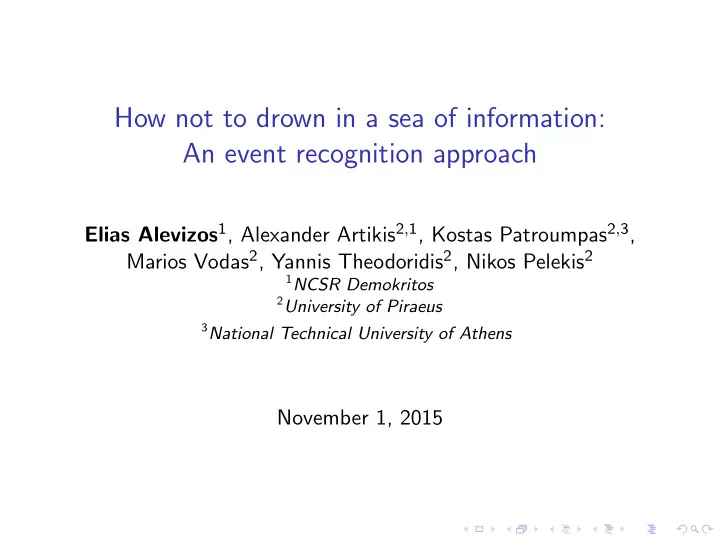

How not to drown in a sea of information: An event recognition approach Elias Alevizos 1 , Alexander Artikis 2 , 1 , Kostas Patroumpas 2 , 3 , Marios Vodas 2 , Yannis Theodoridis 2 , Nikos Pelekis 2 1 NCSR Demokritos 2 University of Piraeus 3 National Technical University of Athens November 1, 2015
Goals & Motivation ◮ 580,000 AIS-equipped vessels worldwide ◮ Distributed sources ◮ Ambiguous/uncertain messages ◮ Build a system monitoring the activity of thousands of vessels, transmitting AIS messages every few seconds. ◮ Incorporate spatial, background knowledge (thousands of special areas of interest). ◮ Real-time performance. ◮ Scalability with enlarged datasets.
Motivating example (1): Fast Approach ◮ A vessel is moving at a high speed ... ◮ towards another vessel ... ◮ away from ports.
Motivating example (2): Package Picking ◮ A vessel stops in a location ... ◮ and another vessel stops in the same location ... ◮ in a short period of time.
Motivating example (3): Possible Rendezvous ◮ Two vessels are suspiciously delayed ... ◮ in the same location ... ◮ at the same time.
Complex Event Recognition
Complex Event Recognition for Maritime Surveillance Input: ◮ Raw input: 168M real-world AIS messages (June–August 2009) ◮ Input to event recognition engine ◮ ≈ 16M critical movement events from 6,5K vessels (95% compression w.r.t. to raw data). ◮ Spatial knowledge ◮ Surveillance area (720 km x 900 km), divided into grid cells. ◮ > 4K areas of interest (e.g. NATURA), with ≈ 78K edges. ◮ 64 ports. Output: ◮ Spatio-temporal events/activities of interest (e.g. package picking ).
Approach: Run-Time Event Calculus ◮ A logic programming language for representing and reasoning about events and their effects ◮ formal, declarative semantics. ◮ Succinct representation of complex temporal phenomena ◮ Intuitive representation → facilitates interaction with domain experts unfamiliar with programming. ◮ Support for intervals. ◮ Support for hierarchical knowledge. ◮ Combination of streaming data with background atemporal knowledge.
Empirical Evaluation (a) Average recognition (b) Average number of (c) Average number of times. Movement Events Complex Events (input). (output). ◮ ≈ 16M Movement Events, 6,5K vessels, 4K areas (78K edges), 900 cells (720 km x 900 km) ◮ Real-time performance
Summary ◮ Sustain large amounts of streaming messages from vessels. ◮ ... from real data. ◮ Real-time response. ◮ Patterns motivated from real-world demands (to work on refinement).
Current and future work ◮ Performance ◮ Larger datasets ◮ Test different partition schemes ◮ More efficient parallelization (rewrite engine in Spark) ◮ Accuracy ◮ Pattern refinement ◮ Include historical, statistical, contextual data ◮ Probabilistic extensions ◮ Ground truth?
Current and future work (d) Average recognition (e) Average number of (f) Average number of times. Movement Events Complex Events (input). (output). Experiments with synthetically enlarged datasets ◮ Increase factor 20–200, 320M–3,2B Movement Events, 128K–1,28M vessels, 4K areas.
Recommend
More recommend